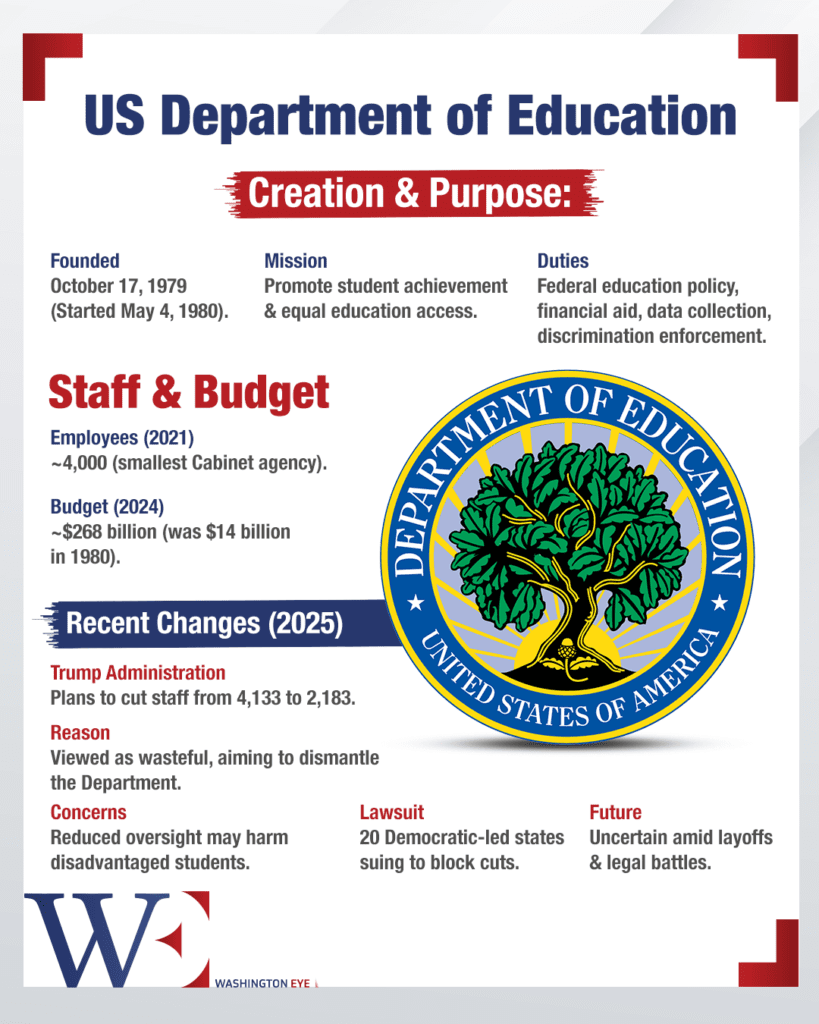In a landmark move reflecting the Trump administration’s intent to overhaul federal involvement in education, the U.S. Department of Education has announced a significant reduction in its workforce, effectively cutting nearly 50% of its staff. This decision aligns with President Donald Trump’s longstanding objective to dismantle the department and transfer educational oversight to individual states.
On March 11, 2025, the Department of Education disclosed plans to reduce its staff from approximately 4,100 employees to about 2,180. This reduction includes the termination of over 1,300 employees, supplemented by voluntary resignations and retirements over the past seven weeks. Education Secretary Linda McMahon characterized this action as a “significant step toward restoring the greatness of the United States education system,” emphasizing the department’s commitment to “efficiency, accountability, and ensuring that resources are directed where they matter most: to students, parents, and teachers.”
Implementation and Immediate Actions
In conjunction with the layoffs, the department announced the closure of its Washington, D.C., headquarters and regional offices in cities such as New York, Boston, Chicago, and Cleveland for “security reasons” on March 12, 2025. Affected employees are slated to be placed on administrative leave starting March 21, 2025, with provisions for full pay and benefits until June 9, 2025, in addition to severance and retirement benefits.
President Trump’s initiative to reduce the federal government’s footprint includes the eventual elimination of the Department of Education. This strategy is rooted in the belief that educational governance should be decentralized, granting states greater autonomy over their educational systems. Trump has previously criticized the department as being overtaken by “radicals, zealots, and Marxists,” advocating for a return of control to state and local authorities.
Secretary McMahon echoed this sentiment, stating that upon her appointment, she aimed to “reduce bloat to be able to send more money to local education authorities,” ensuring that “the money goes to the states.” The Department of Education, established in 1979, has faced criticism from various political factions over the decades. The current administration’s efforts to dismantle the department represent the most aggressive attempt to date. However, completely abolishing the department requires congressional approval, a formidable challenge given the need for a 60-vote majority in the Senate.
Despite the substantial staff reductions, the department asserts that it will continue to fulfill its statutory obligations, including the distribution of federal aid to schools, management of student loans, oversight of Pell Grants, and support for special needs students. Secretary McMahon assured that essential student services would remain unaffected.
Critics, however, express concerns about the potential impact on public education. Democratic leaders and education advocates argue that such significant cuts could harm federal education programs, increase class sizes, and decrease the quality of education. Senator Elizabeth Warren and American Federation of Teachers President Randi Weingarten have been vocal in their opposition, suggesting that these cuts will harm federal education programs and students’ education.
Broader Governmental Restructuring
The workforce reduction at the Department of Education is part of a broader governmental downsizing directed by President Trump. Similar cuts are anticipated across other federal agencies, including the Department of Veterans Affairs and the Social Security Administration, as the administration seeks to streamline operations and reduce federal oversight in favor of state control. The announcement has elicited a spectrum of reactions. Proponents argue that reducing federal interference will empower state and local leaders to tailor educational programs to their communities’

















